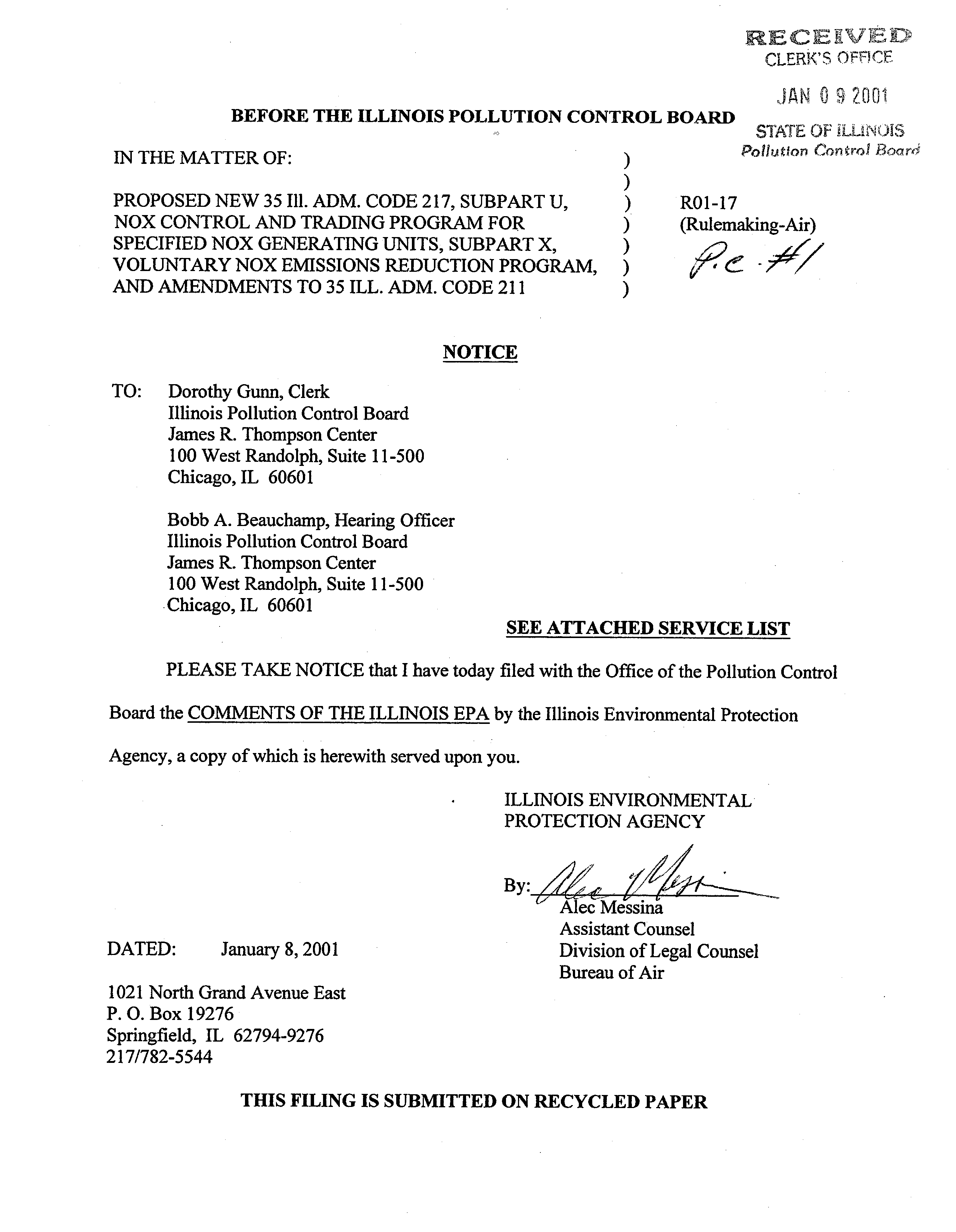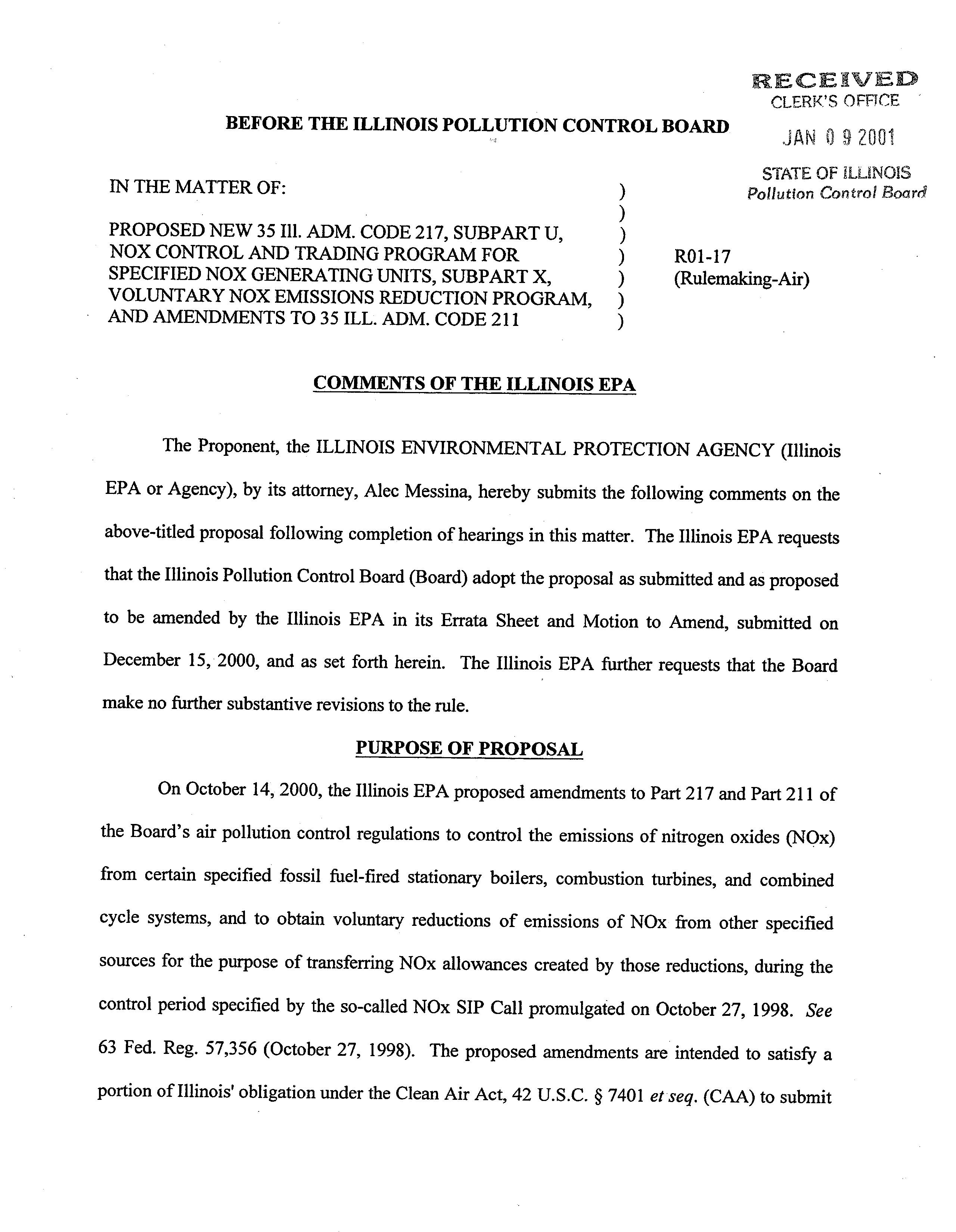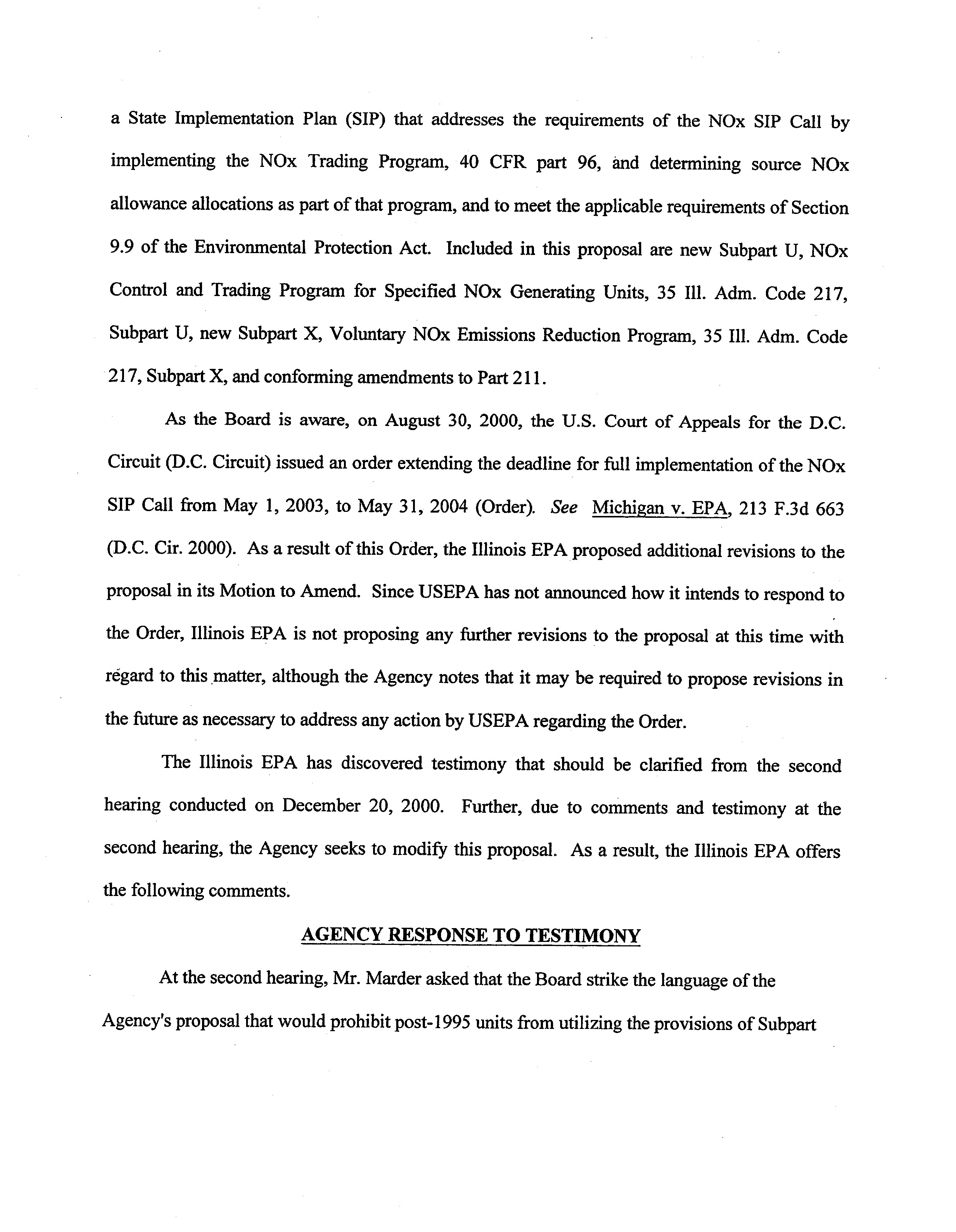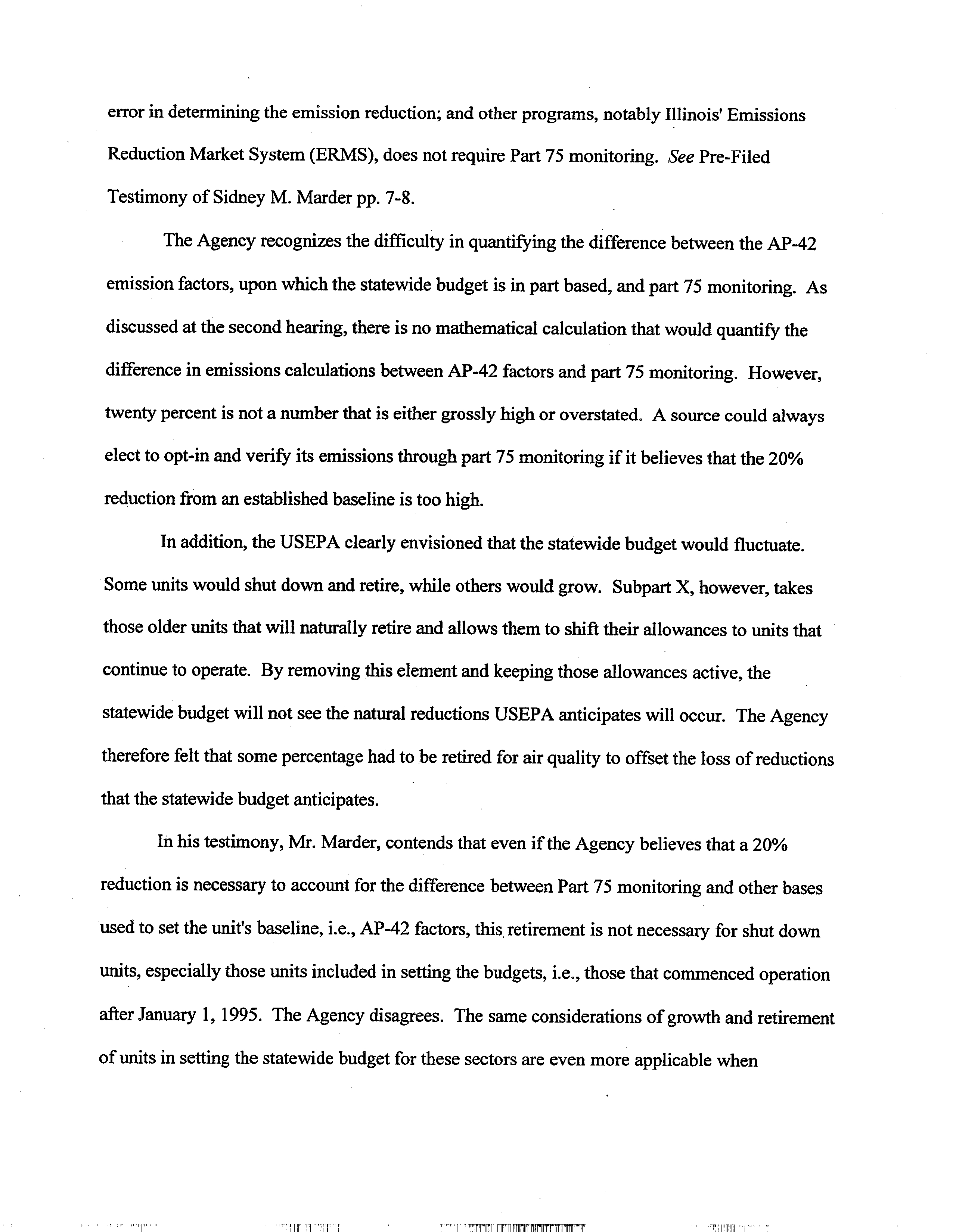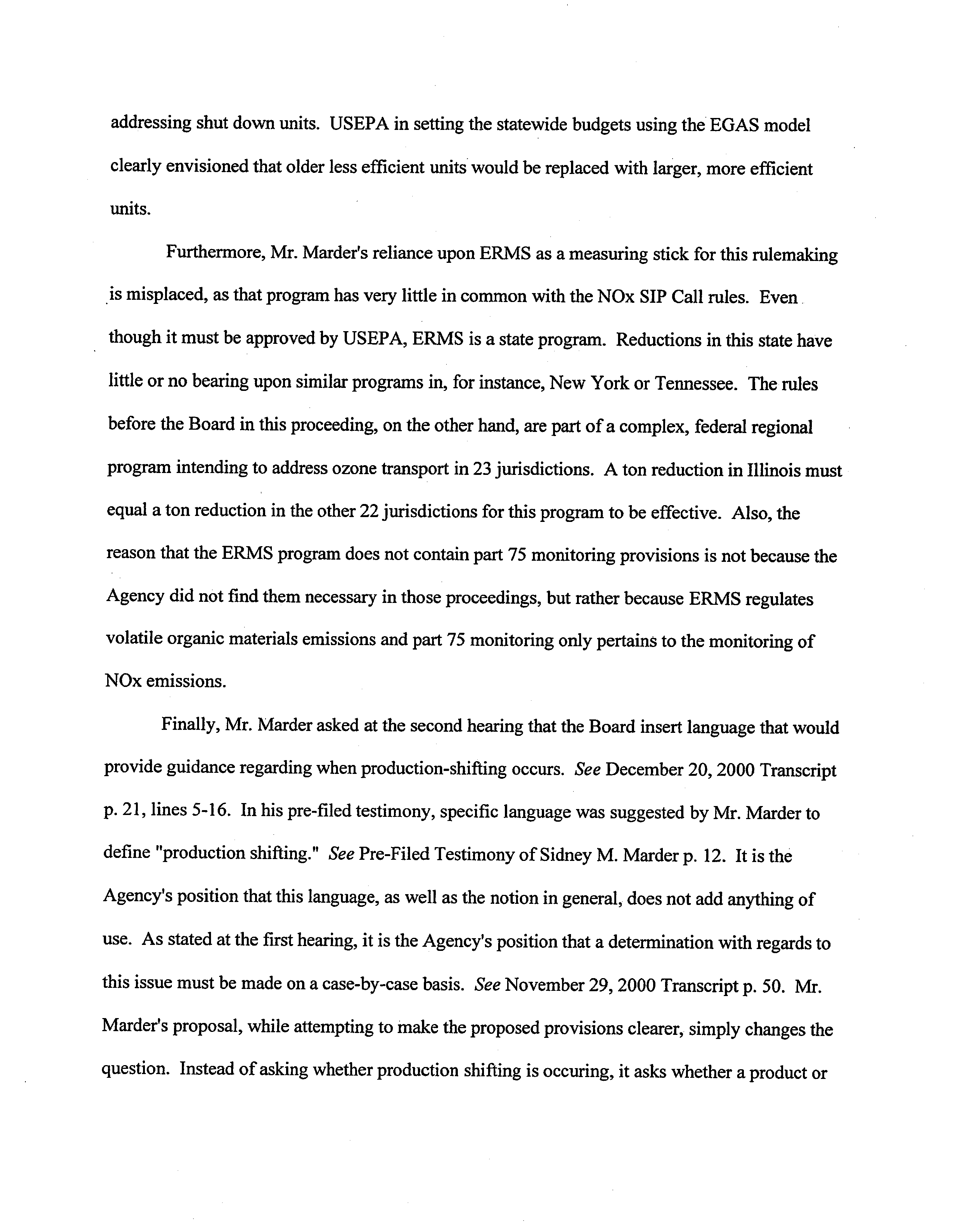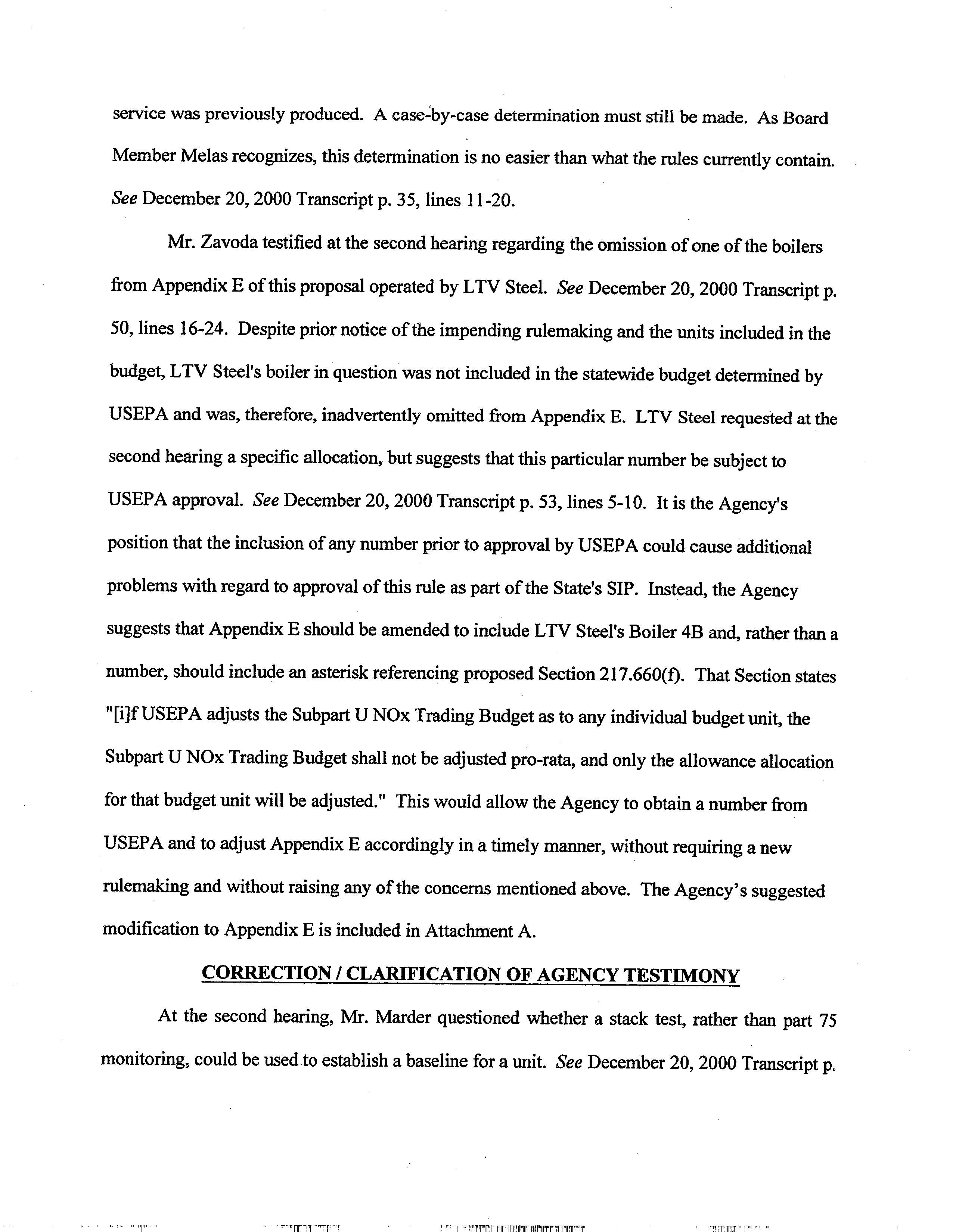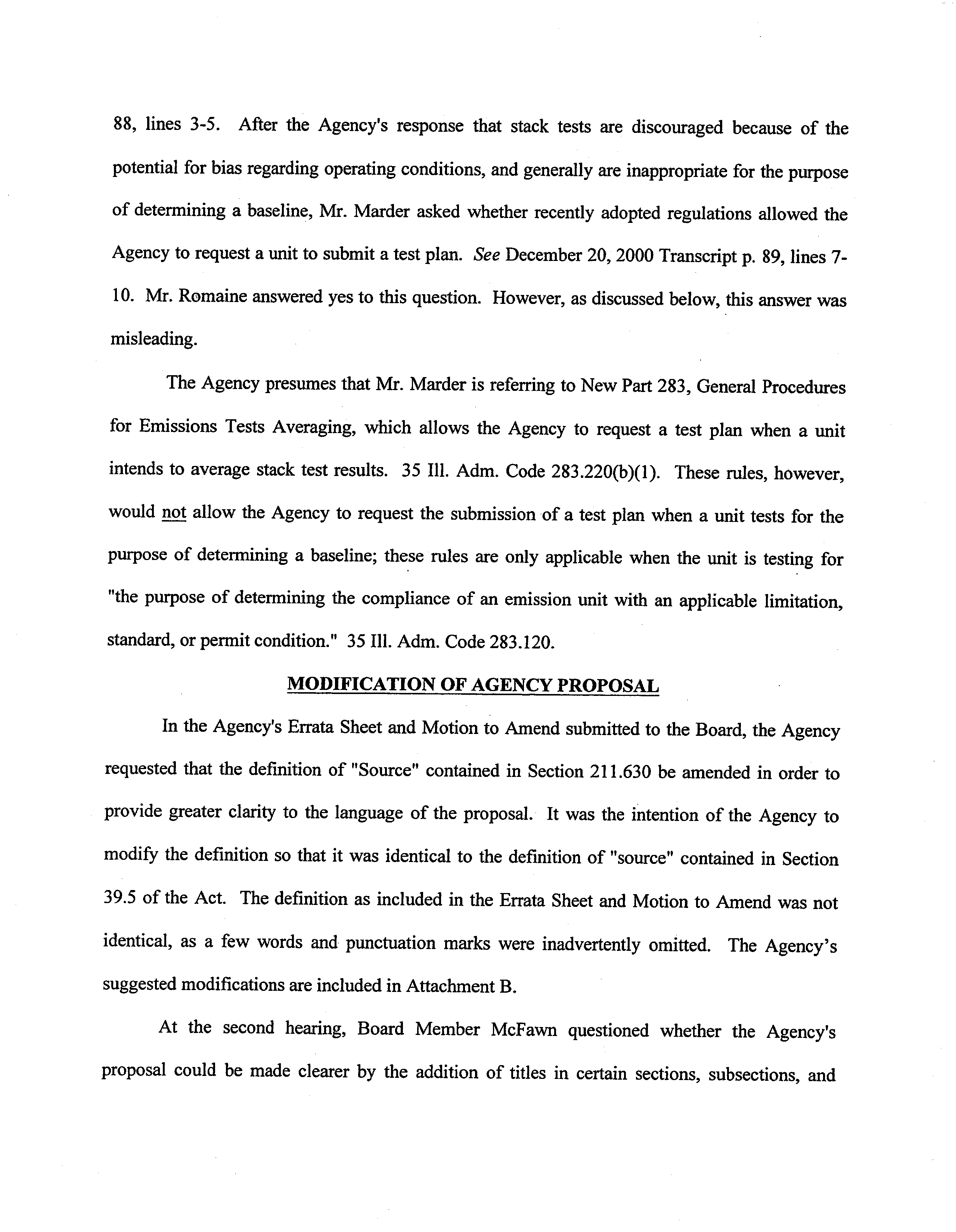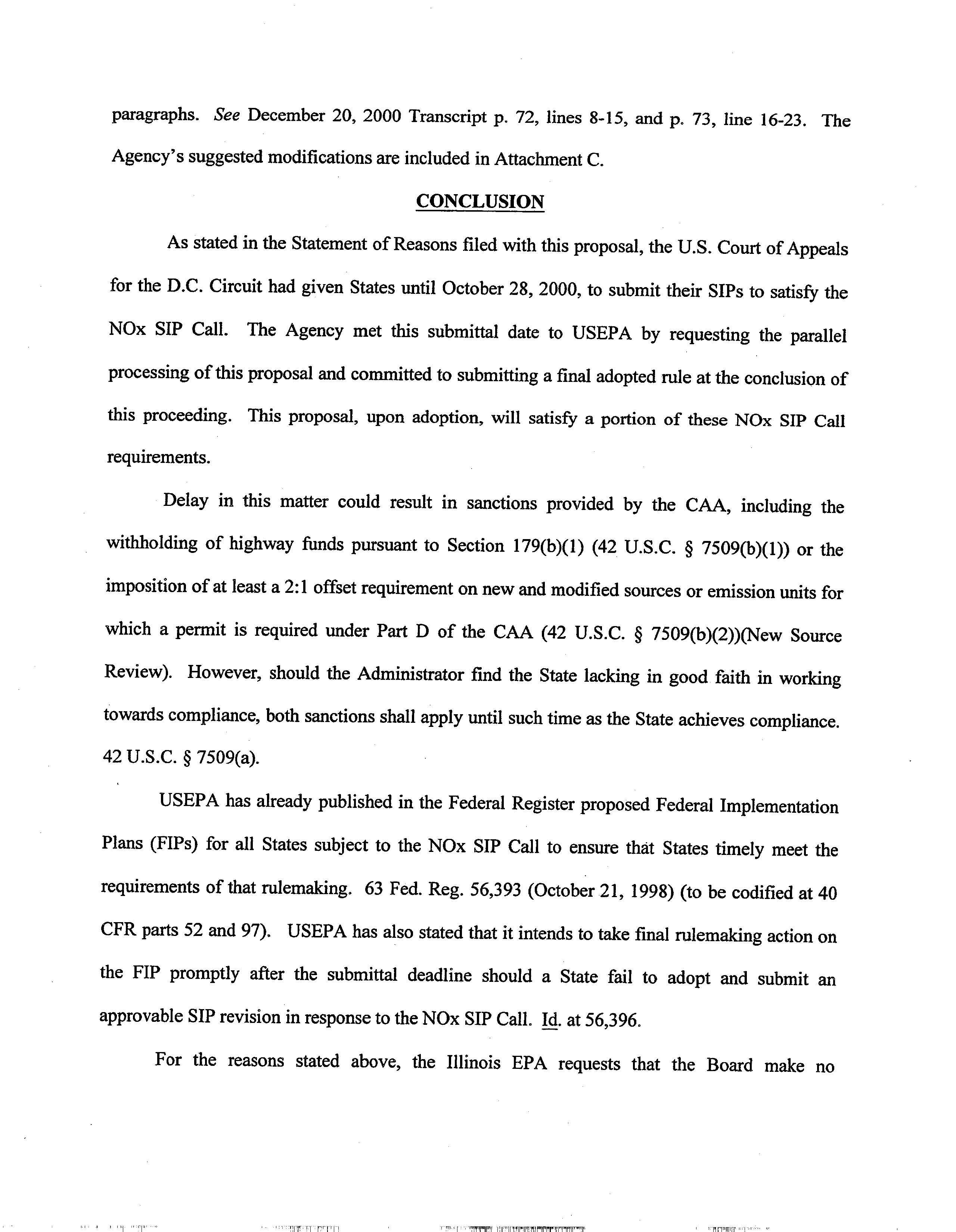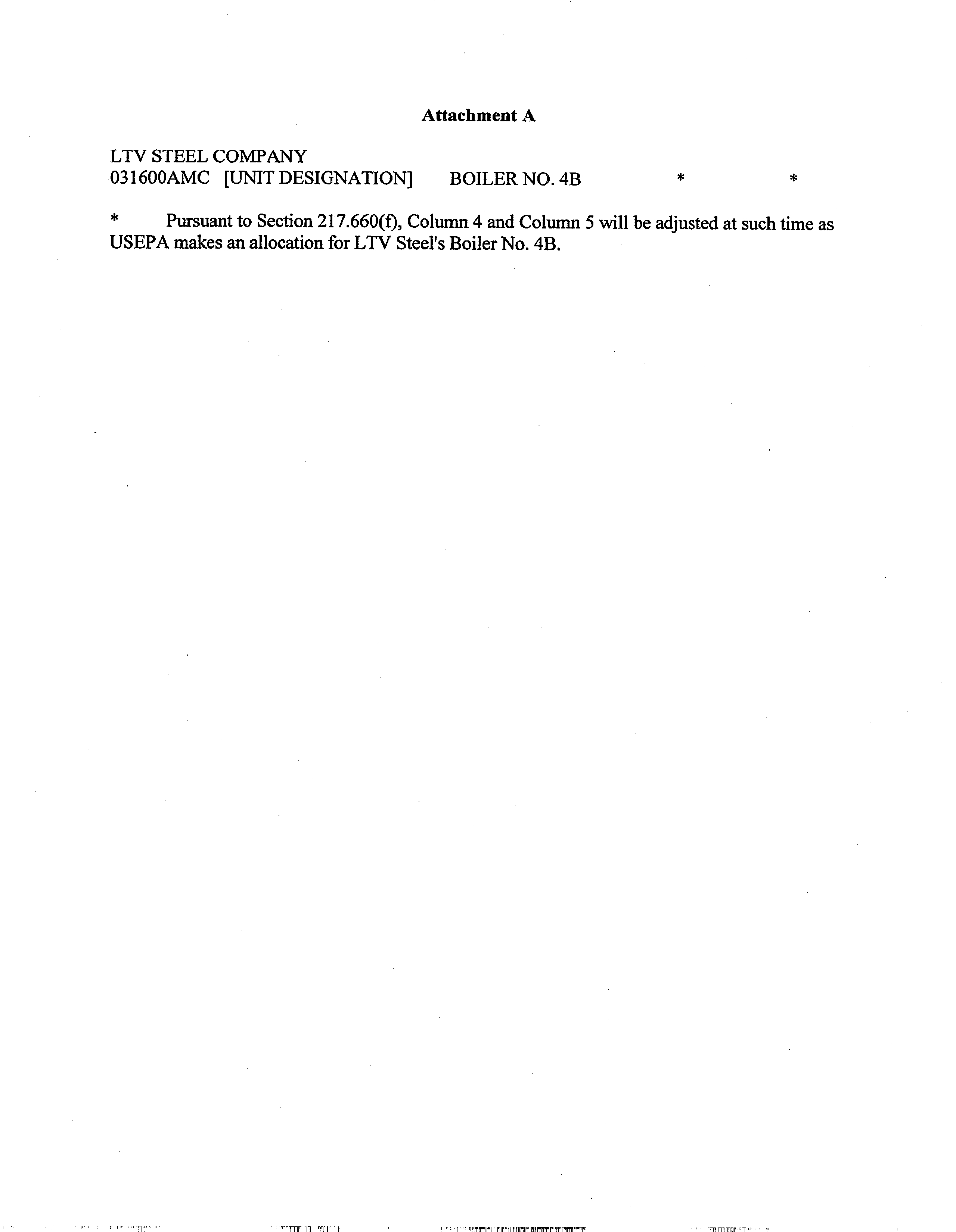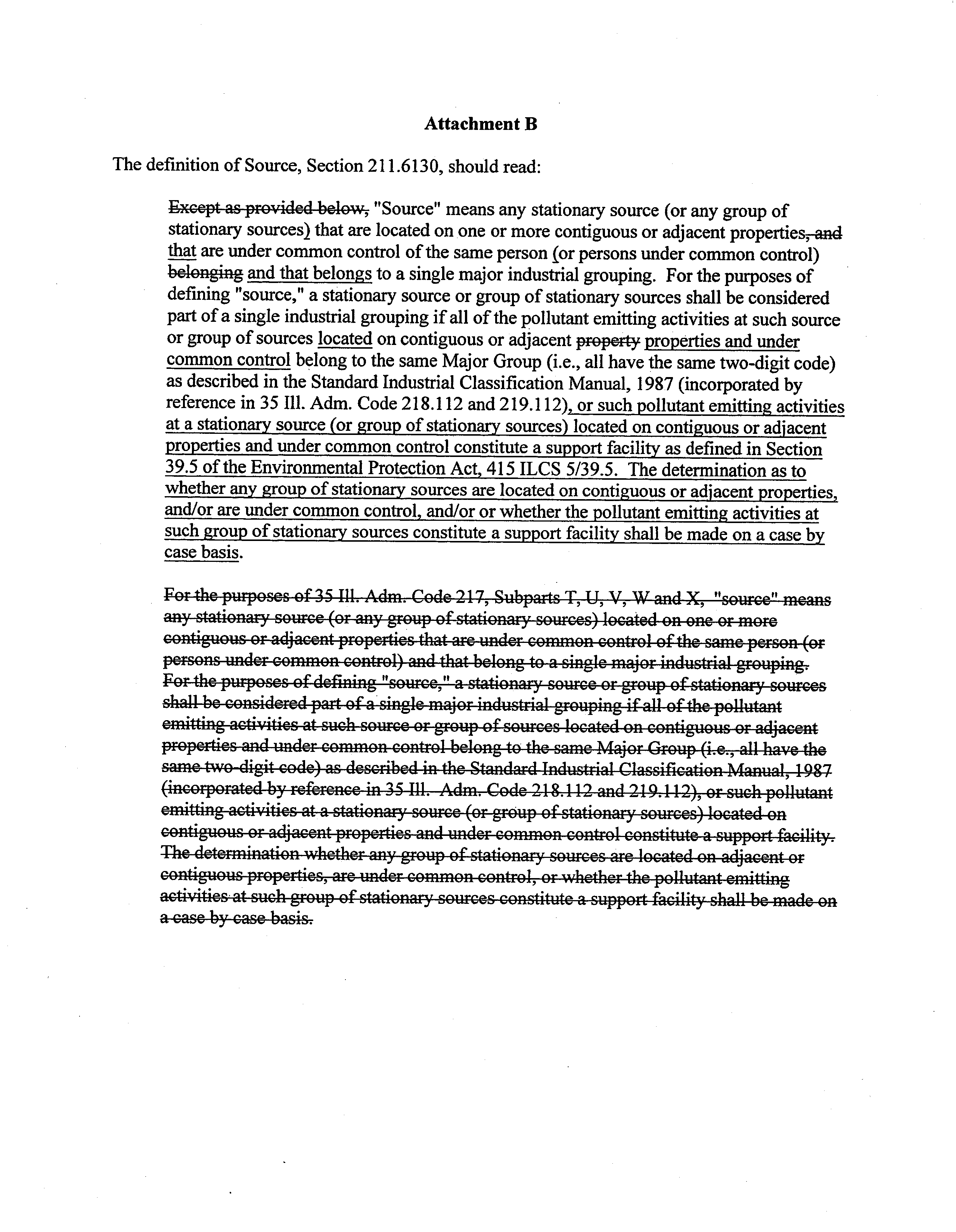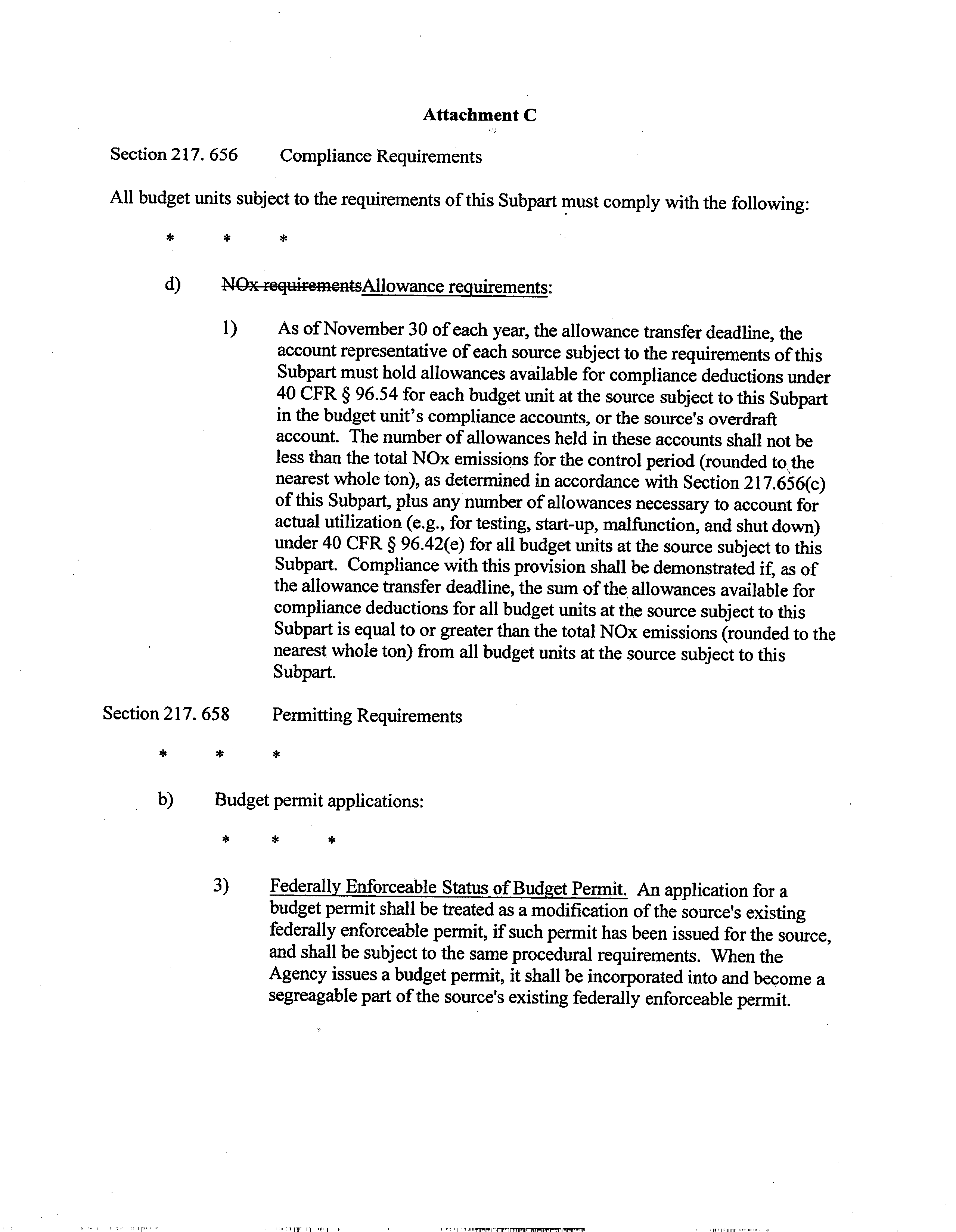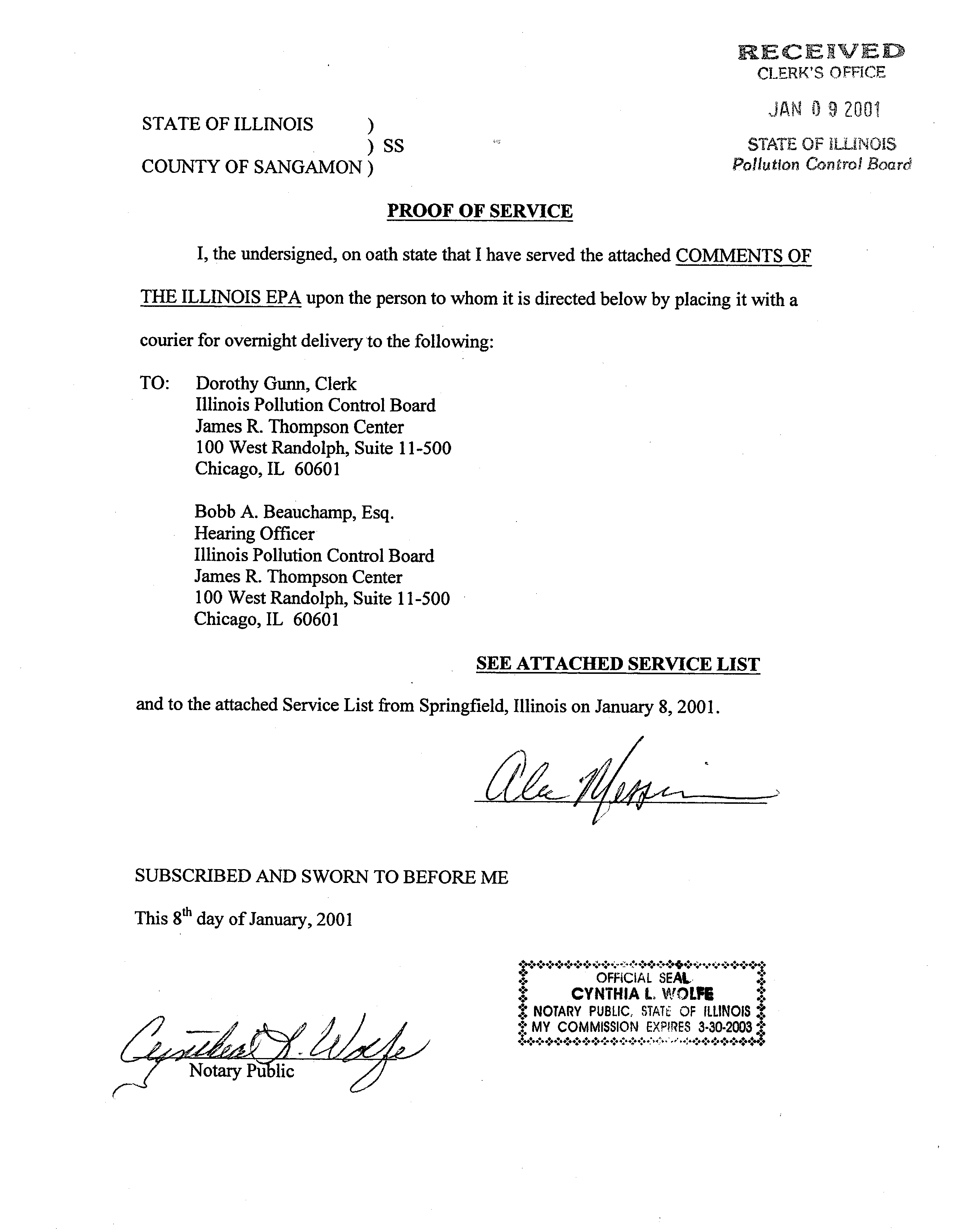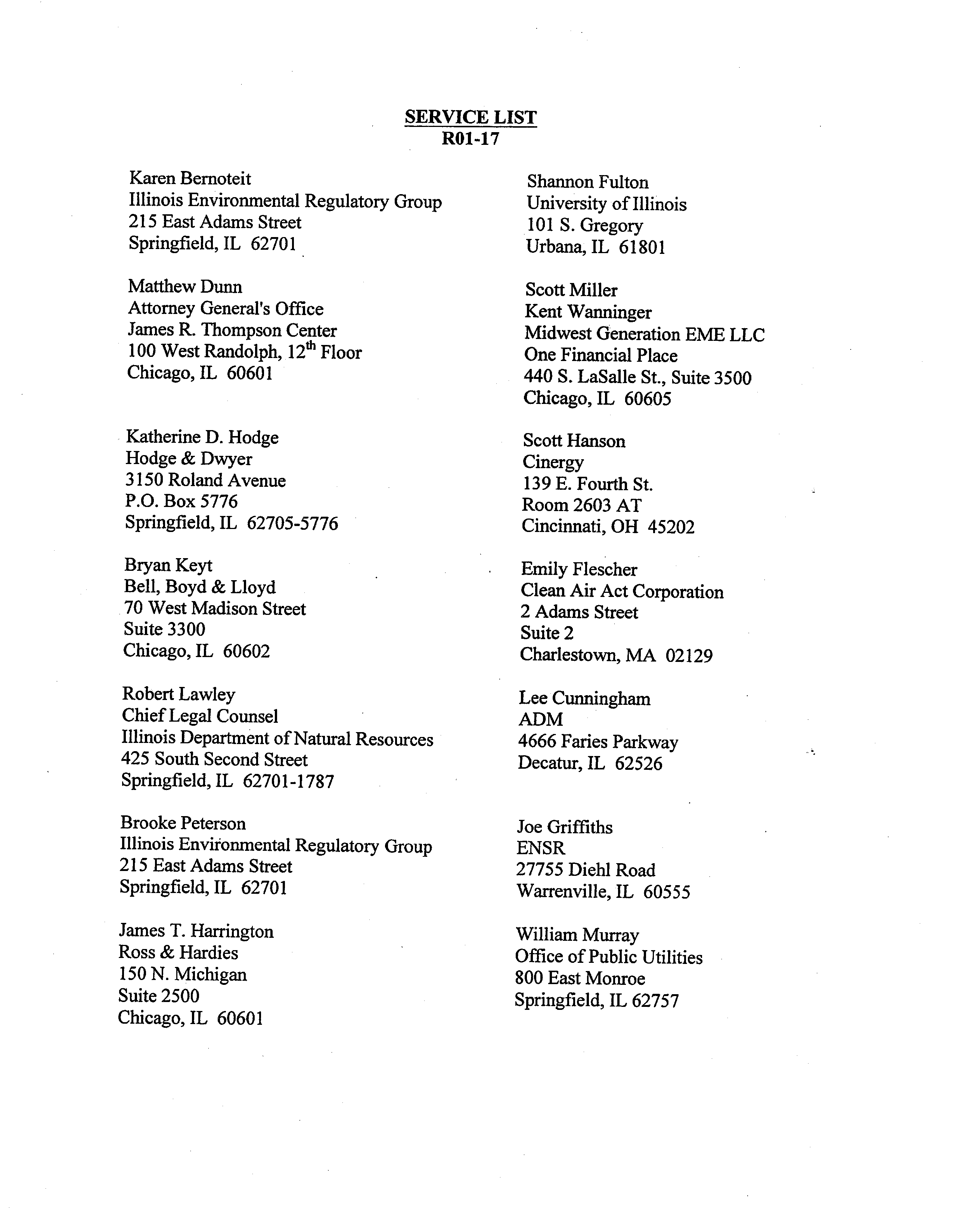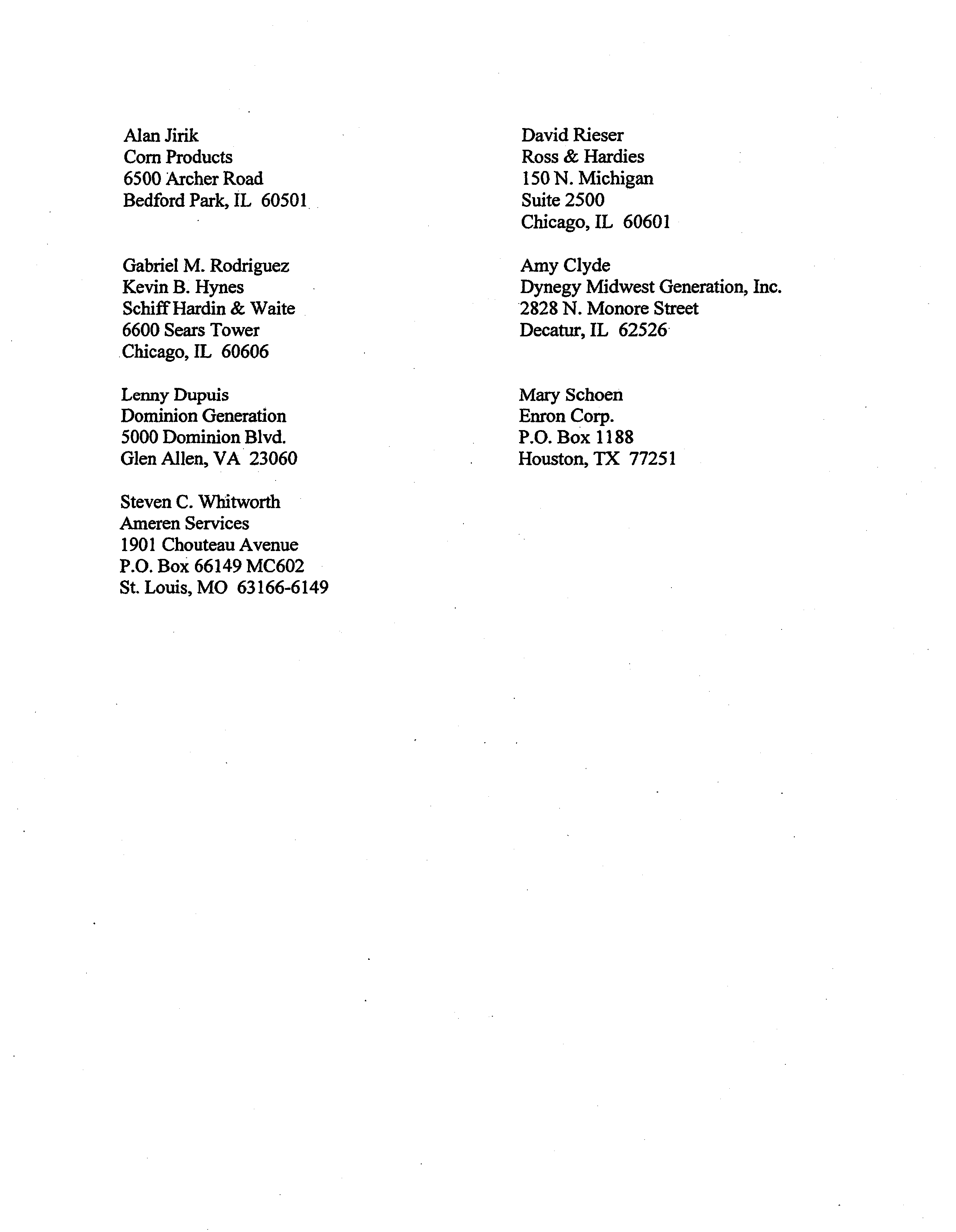CLER&S OFF)(E
BEFORE THE ILLINOIS POLLUTION CONTROL BOARD
IN THE MATTER OF:
)
PROPOSED NEW 35111. ADM. CODE 217, SUBPART U,
NOX CONTROL AND TRADING PROGRAM FOR
SPECIFIED NOX GENERATING UNITS, SUBPART X,
VOLUNTARYNOX EMISSIONS REDUCTION PROGRAM,
AND AMENDMENTS TO
35
ILL. ADM. CODE 211
)
)
)
)
)
)
2xm~
SIATE OF ~LLiN~)iS
PoIk~tion
Con~roJ Bo~rts
RO1-17
(Rulemaking-Air)
~
.~#
NOTICE
TO:
Dorothy Gunn, Clerk
Illinois Pollution Control Board
James R. Thompson Center
100 West Randolph, Suite 11-500
Chicago, IL
60601
Bobb A. Beauchamp, Hearing Officer
Illinois Pollution Control Board
James
R. Thompson Center
100 West Randolph, Suite 11-500
Chicago, IL
60601
SEE ATTACHED SERVICE LIST
PLEASE TAKE NOTICE that I have today filed with the Office ofthe Pollution Control
Board the COMMENTS OF THE ILLINOIS EPA by the Illinois Environmental Protection
Agency, a copy of which is herewith served upon you.
ILLINOIS ENVIRONMENTAL
PROTECTION AGENCY
By:
6
Alec Messina
DATED:
Assistant Counsel
Division of Legal Counsel
January 8, 2001
Bureau ofAir
1021
North Grand Avenue East
P. 0. Box
19276
Springfield,
IL
62794-9276
217/782-5544
THIS FILING IS SUBMITTED ON RECYCLED PAPER
RECE~V~D
CLERJCq OFFICE
BEFORE THE ILLINOIS POLLUTION CONTROL BOARD
0
2CIO1~
STATE OF
LLINOIS
IN THE MATTER OF:
)
Pollution
Control Bonrd
)
PROPOSED NEW 35111. ADM. CODE 217,
SUBPART U,
)
NOX CONTROL AND TRADING PROGRAM FOR
)
RO1-17
SPECIFIED NOX GENERATING UNITS,
SUBPART X,
)
(Rulemaking-Air)
VOLUNTARY NOX EMISSIONS
REDUCTION PROGRAM,
)
AND AMENDMENTS TO 35 ILL. ADM. CODE 211
)
COMMENTS
OF THE ILLINOIS EPA
The Proponent,
the ILLINOIS ENVIRONMENTAL
PROTECTION AGENCY (Illinois
EPA or Agency),
by its attorney,
Alec Messina, hereby submits the following comments
on the
above-titled proposal following completion ofhearings in this matter.
The Illinois EPA requests
that the Illinois Pollution Control Board (Board) adopt the proposal as submitted and as proposed
to
be
amended
by
the
Illinois
EPA
in
its
Errata
Sheet
and
Motion
to
Amend,
submitted
on
December
15,
2000,
and as set
forth
herein.
The
Illinois
EPA further requests
that the Board
make no further substantive revisions to the rule.
PURPOSE OF PROPOSAL
On October
14, 2000, the Illinois EPA proposed amendments to Part 217
and Part 211 of
the Board’s air pollution control regulations to
control the emissions of nitrogen oxides
(NOx)
from
certain specified
fossil
fuel-fired
stationary
boilers,
combustion
turbines,
and
combined
cycle
systems,
and to
obtain
voluntary
reductions of emissions of NOx
from other specified
sources
for the purpose oftransferring NOx
allowances
created
by
those reductions, during the
control period specified
by the so-called NOx
SIP
Call promulgated on
October 27,
1998.
See
63
Fed.
Reg.
57,356
(October 27,
1998).
The proposed amendments are
intended to
satisfy
a
portion ofIllinois’ obligation under the Clean Air Act, 42 U.S.C.
§
7401
et seq.
(CAA)
to submit
a
State
Implementation
Plan
(SIP)
that
addresses
the
requirements of the
NOx
SIP
Call
by
implementing
the
NOx
Trading
Program,
40
CFR
part
96,
and
determining
source
NOx
allowance allocations as part of that program, and to meet the applicable requirements ofSection
9.9
of the Environmental
Protection
Act.
Included in
this
proposal
are new Subpart
U, NOx
Control
and
Trading
Program
for Specified
NOx
Generating
Units,
35
Ill.
Adm.
Code
217,
Subpart
U, new Subpart
X, Voluntary
NOx Emissions
Reduction Program,
35
Ill.
Adm.
Code
217, Subpart X, and conforming amendments to Part 211.
As
the
Board
is
aware,
on
August
30,
2000,
the
U.S.
Court of Appeals for
the D.C.
Circuit (D.C.
Circuit) issued
an order extending the deadline for full implementation of the NOx
SIP
Call
from May 1,
2003,
to May 31,
2004
(Order).
See
Michigan v.
EPA,
213
F.3d
663
(D.C.
Cir. 2000).
As a result ofthis Order, the Illinois
EPA proposed additional revisions to the
proposal in its Motion to Amend.
Since USEPA has not announced how it intends to respond to
the Order,
Illinois EPA
is not proposing
any
further revisions
to the proposal
at this
time with
regard to this
matter, although the Agency
notes that it may be required to propose revisions in
the future as necessary to address any action by USEPA regarding the Order.
The
Illinois
EPA
has
discovered testimony
that
should
be
clarified
from
the
second
hearing
conducted
on
December
20,
2000.
Further,
due
to
comments
and
testimony
at the
second hearing, the Agency seeks to
modify this proposal.
As
a result, the Illinois
EPA offers
the following comments.
AGENCY RESPONSE
TO TESTIMONY
At the second hearing, Mr. Marder asked that the Board strike the language ofthe
Agency’s proposal that would prohibit post-1995 units from utilizing the provisions ofSubpart
X.
See
December 20, 2000 Transcript p.
17,
lines 2-4.
It is the Agency’s position that the
omission or striking ofthis language would create functional problems for this program.
Functionally speaking, Subpart X represents a shift from the non-trading portion ofthe
statewide NOx budget to the trading portion.
To effectuate such a shift, there must be a clearly
defined universe of sources from where allowances can be shifted.
Ifthat universe is
constantly
expanding, it becomes very difficult to show with certainty what effect there has beenupon the
statewide budget.
Further complicating matters, post-1995 units will not be in the inventory and thus will
not have a baseline.
To ensure the integrity ofthis program, determining the baseline is
essential.
TheNOx SIP Call set statewide budgets based on a 1995 inventory, and requires each
state to demonstrate that it has met this budget triennially, but it does not require controls or
emission limitations on all NOx emitting units, nor does it limit the construction ofnew sources
ofNOx.
In order to support ourposition that budget shifting should occur outside ofthe opt-in
provisions ofthe NOx SIP Call that require part 75 monitoring, the Agency believes it is
essential to limit participation in the program to units that were included in
setting the budgetand
thus have an established baseline set in the statewide budget, i.e., those that commenced
operation before January
1,
1995.
Again at the second hearing, Mr. Marder asked that the Board strike the language ofthe
Agency’sproposal requiring the retirement of20
ofthe emissions reductions generated by
Subpart X.
See
December 20, 2000 Transcript p.
18, lines 22-24.
The rationale forthis request
is detailed in the pre-filed testimony, but is essentially based on the following three points:
with
regards to restricted-operation units, the difference in validity between Part 75 monitoring and
othermonitoring protocols cannot be 20;
with regards to shut-down units, there is no margin of
error in determining the emission reduction; and other programs, notably Illinois’ Emissions
Reduction Market System (ERMS), does not require Part
75
monitoring.
See
Pre-Filed
Testimony of Sidney M. Marder pp.
7-8.
The Agency recognizes the difficulty in quantifying the difference between the AP-42
emission factors, upon which the statewide budget is in part based, and part 75 monitoring.
As
discussedat the second hearing, there is no mathematical calculation that would quantify the
difference in emissions calculations
between AP-42 factors and part 75 monitoring.
However,
twenty percent is not a number that is either grossly high or overstated.
A source could always
elect to opt-in and verify its emissions through part 75 monitoring if it believes that the 20
reduction from an established baseline is too high.
In addition, the USEPA clearly envisioned that the statewide budget would fluctuate.
Some units would shut down and retire, while others would grow.
Subpart
X, however, takes
those older units that will naturally retire and allows them to shift their allowances to units that
continue to operate.
By removing this element and keeping those allowances active, the
statewide budget will not see the natural reductions USEPA anticipates will occur.
The Agency
therefore feltthat
some percentage had to be retired for airquality to offset the loss ofreductions
that the statewide budget anticipates.
In his testimony, Mr. Marder,
contends that even if the Agency believes that a 20
reduction is necessary to account for the difference between Part 75 monitoring and other bases
used to set the unit’s baseline, i.e., AP-42 factors, this retirement is not necessary for shut down
units, especially those units included in setting the budgets, i.e., those that commenced operation
after January
1,
1995.
The Agency disagrees.
The same considerations ofgrowth and retirement
ofunits in setting the statewide budget for these sectors are even more applicable when
V
~1Tl~FFI~I~¶~TFWTh~1
PV
addressing shut down units.
USEPA in setting the statewide budgets using the EGAS model
clearly envisioned that older less efficient units would be replaced with larger, more efficient
units.
Furthermore, Mr. Marder’s reliance upon ERMS as a measuring stick for this rulemaking
is misplaced, asthat programhas very little in common with the NOx SIP Call rules.
Even
though it must be approved by USEPA, ERMS
is a state program.
Reductions
in this state have
little or no bearing upon similar programs in, for instance, New York or Tennessee.
The rules
before the Board in this proceeding, on the other hand,
are part of a complex, federal regional
program intending to address ozone transport in 23 jurisdictions.
A ton reduction in Illinois must
equal a ton reduction in the other 22 jurisdictions for this program to be effective.
Also, the
reason that the ERMS program does not contain part 75 monitoring provisions
is not because the
Agency did not find them necessary in those proceedings, but ratherbecause ERMS regulates
volatile organic materials emissions and part 75
monitoring only pertains to the monitoring of
NOx emissions.
Finally, Mr. Marder asked at the second hearing that the Board insert language that would
provide guidance regarding whenproduction-shifting occurs.
See
December 20, 2000 Transcript
p. 21,
lines
5-16.
In his pre-filed testimony,
specific language was suggested by Mr. Marder to
define “production shifting.”
See
Pre-Filed Testimony ofSidney M. Marder p.
12.
It is the
Agency’s position that this language, as well as the notion in general, does not add anything of
use.
As stated at the first hearing, it is the Agency’s position that a determination with regards to
this issue must be made on a case-by-case basis.
See
November 29, 2000 Transcript p.
50.
Mr.
Marder’s proposal, while attempting to make the proposed provisions clearer, simply changes the
question.
Instead ofasking whether production shifting is occuring, itasks whether a product or
service was previously produced.
A case-by-case determination must still be made.
As Board
Member Melas recognizes, this determination is no easier than what the rules
currently contain.
See
December 20, 2000 Transcript p. 35,
lines 11-20.
Mr. Zavoda testified at the second hearing regarding the omission of one ofthe boilers
from Appendix E ofthis proposal operated by LTV Steel.
See
December 20, 2000 Transcript p.
50,
lines 16-24.
Despite prior notice ofthe impending rulemaking and the units included in the
budget, LiN
Steel’s boiler in question was not included in the statewide budget determined by
USEPA and was,therefore, inadvertently omitted from Appendix E.
LTV
Steel requested at the
second hearing a specific allocation, but suggests that this particular number be subject to
USEPA approval.
See
December 20,
2000 Transcript p.
53,
lines
5-10.
It is the Agency’s
position that the inclusion ofany number prior to approval by USEPA could cause additional
problems with regard to approval ofthis rule as part ofthe State’s SIP.
Instead, the Agency
suggests that Appendix E should be amended to include LTV Steel’s Boiler 4B and, ratherthan a
number, should include an asterisk referencing proposed Section 217.660(f).
That Section states
“ilf
USEPA adjusts the Subpart U NOx Trading Budget asto any individual budget unit, the
Subpart U NOx Trading Budget shall not be adjusted pro-rata, and only the allowance allocation
for that budget unit will
be adjusted.”
This would allow the Agency to obtain a number from
USEPA and to adjust Appendix E accordingly in a timely manner, without requiring a new
rulemaking and withoutraising any ofthe concerns mentioned above.
The Agency’s suggested
modification to Appendix E is included in Attachment A.
CORRECTION
I
CLARIFICATION OF AGENCY TESTIMONY
At
the second
hearing, Mr. Marder
questioned whether a
stack test, rather than part 75
monitoring, could be usedto establish a baseline fora unit.
See
December 20, 2000 Transcript p.
FTV’7
TFV
V
~‘FTW7
88,
lines
3-5.
After
the
Agency’s
response
that
stack
tests
are
discouraged
because
of the
potential
for bias regarding operating conditions, and generally are inappropriate for the purpose
of determining a baseline,
Mr. Marder asked
whether recently
adopted regulations
allowed the
Agency to request a unit to submit a test plan.
See
December 20, 2000 Transcript p.
89, lines 7-
10.
Mr. Romaine answered yes to this
question.
However, as discussed below, this answer was
misleading.
The Agency
presumes that
Mr. Marder is referring to New Part 283,
General Procedures
for
Emissions
Tests
Averaging,
which
allows
the
Agency
to
request a
test plan when a
unit
intends to
average
stack test results.
35
Ill. Adm.
Code
283.220(b)(l).
These
rules,
however,
would
not allow the Agency
to
request the submission of a test plan when a unit tests for the
purpose of determining a baseline;
these rules
are
only
applicable when the unit is testing
for
“the purpose of determining the
compliance of an
emission unit with
an
applicable
limitation,
standard, or permit condition.”
35 Ill. Adm.
Code 283.120.
MODIFICATION OF AGENCY PROPOSAL
In the Agency’s Errata
Sheet and Motion to Amend submitted to the Board, the Agency
requested that
the definition of “Source”
contained in
Section
211.630
be amended
in
order to
provide greater
clarity to
the
language of the proposal.
It
was the intention of the
Agency
to
modify the
definition so that it was identical
to
the definition of “source” contained
in
Section
39.5 of the Act.
The definition
as included in the Errata Sheet and Motion
to
Amend
was not
identical,
as
a few
words
and
punctuation
marks
were
inadvertently
omitted.
The
Agency’s
suggested modifications are included in Attachment B.
At
the
second
hearing,
Board
Member
McFawn
questioned
whether
the
Agency’s
proposal
could be
made clearer by
the
addition of titles
in
certain
sections,
subsections,
and
paragraphs.
See
December
20,
2000
Transcript
p.
72,
lines
8-15, and p.
73,
line
16-23.
The
Agency’s suggested modifications are included
in Attachment C.
CONCLUSION
As stated in the Statement ofReasons filed with this proposal, the U.S. Court of Appeals
for the D.C.
Circuit had
given States until
October 28, 2000, to
submit their SIPs to
satisfy the
NOx
SIP
Call.
The
Agency
met
this
submittal
date to
USEPA
by
requesting
the
parallel
processing of this proposal and committed to submitting
a final adopted rule at the conclusion of
this
proceeding.
This
proposal,
upon
adoption,
will
satisfy
a
portion of these
NOx
SIP
Call
requirements.
Delay
in
this
matter
could
result
in
sanctions
provided
by
the
CAA,
including
the
withholding of highway
funds
pursuant
to
Section
179(b)(l)
(42
U.S.C.
§
7509(b)(l))
or the
imposition of at least a 2:1 offset requirement on new and modified sources or emission units for
which
a
permit
is
required under
Part
D
of the CAA
(42
U.S.C.
§
7509(b)(2))(New
Source
Review).
However,
should the
Administrator find
the
State
lacking
in
good
faith in
working
towards compliance, both
sanctions shall apply until such time as the State achieves compliance.
42 U.S.C.
§
7509(a).
USEPA has already
published in the Federal Register proposed Federal
Implementation
Plans
(FIPs)
for all
States
subject to
the NOx
SIP
Call
to
ensure
that
States
timely meet
the
requirements of that rulemaking.
63
Fed.
Reg.
56,393
(October
21,
1998) (to be
codified at 40
CFR parts 52
and 97).
USEPA has also stated that it intends to take final rulemaking action on
the
FIP
promptly
after
the
submittal
deadline
should
a
State
fail
to
adopt
and
submit
an
approvable SIP revision in response to the NOx SIP Call.
Id. at 56,396.
For
the
reasons
stated
above,
the
Illinois
EPA
requests
that
the
Board
make
no
substantive revisions to the proposal not addressed in the Motion to Amend or addressed herein,
and adopt the proposal as so modified.
Respectfully submitted,
ILLINOIS ENVIRONMENTAL
PROTECTION AGENCY
By:
A~c Meksin~
Assistant Counsel
Division ofLegal Counsel
Bureau ofAir
DATED: January 8,2001
1021
N. Grand Avenue East
P.O. Box 19276
Springfield, Illinois 62794-9276
217/782-5544
THIS FILING IS SUBMITTED ON RECYCLED PAPER
Attachment A
LTY STEEL COMPANY
O31600AMC
UNIT
DESIGNATION
BOILER NO. 4B
*
Pursuant to Section 217.660(f), Column 4 and Column
5
will be adjusted at such time as
USEPA makes an allocation for LTV Steel’s Boiler No.
4B.
*
*
~-~mi-~
I
Attachment B
The definition ofSource, Section 211.6130, should read:
Except as provided below,
“Source” means any stationary source (or any group of
stationary sources) that are locatedon one or more contiguous or adjacent properties~4nd
that are under common control ofthe same person (or persons under common control)
b.longing and that belongs to a single major industrial grouping.
For the purposes of
defining “source,” a stationary source or group ofstationary sources shall be considered
part ofa single industrial grouping if all ofthe pollutant emitting activities at such source
or group of sources located on contiguous or adjacent pfepeity properties and under
common control belong to the same Major Group (i.e., all have the same two-digit code)
as described in the Standard Industrial Classification Manual,
1987 (incorporated by
reference in 35 Ill. Adm.
Code 218.112 and 219.112), or such pollutant emitting activities
at a stationary source (or group ofstationary sources) located on contiguous or adjacent
properties and under common control constitute a support facility as defined in Section
39.5 ofthe Environmental Protection Act, 415 ILCS
5/39.5.
The determination as to
whether any group of stationary sources are locatedon contiguous or adjacent properties,
and/or are under common control, and/oror whetherthe pollutant emitting activities at
such group ofstationary sources constitute a support facility shall be made on a case by
case basis.
For the purposes of35 III. Adm.
Code 217,
Subparts T, U, V, Wand X,
“source” means
any stationary
source (or any group of stationary sources) located
on one or more
contiguous or adjacent properties that are under
common control ofthe sameperson (or
persons under common control) and that belong to a single major industrial grouping.
Forthe purposes ofdefining “source,” a stationa~’ source or group ofstationary
sources
shall be consideredpart ofa single major industrial grouping if all ofthepollutant
emitting activities at such source or group ofsources located on contiguous or adjacent
properties and under common control belong to the same Major Group (i.e., all have the
same two
digit code) as described in the Standard Industrial Classification Manual,
1987
(incorporated by reference in 35 Ill.
Adm.
Code 218.112 and 219.112), or such pollutant
emitting activities at a stationary source (or group ofstationary sources) located on
contiguous or adjacent properties and under common control constitute a support facility.
The determination whether any group of stationary sources are located on adjacent or
contiguous properties, are under common control, orwhether the pollutantemitting
activities at such group ofstationary sources constitute a support facility shall be made on
a case by case basis.
Attachment C
Section 217.
656
Compliance Requirements
All budget units subject to the requirements ofthis Subpart must comply with the following:
*
*
*
d)
NO
eq ikei~ntsAllowance requirements:
I)
As ofNovember 30 ofeach year, the allowance transfer deadline, the
account representative ofeach source subject to the requirements ofthis
Subpart must hold allowances available for compliance deductions under
40 CFR
§
96.54 for each budgetunit at the source subject to this Subpart
in the budget unit’s compliance accounts, orthe source’s overdraft
account.
The number ofallowances held in these accounts shall not be
less than the total NOx emissions for the control period (rounded to~the
nearest whole ton), as determined in accordance with Section
217.656(c)
ofthis Subpart, plus anynumber ofallowances necessary to account for
actual utilization (e.g., fortesting, start-up, malfunction, and shut down)
under 40 CFR
§
96.42(e) for all budget units at the source subject to this
Subpart.
Compliance with this provision shall be demonstrated if, as of
the allowance transfer deadline, the sum ofthe allowances available for
compliance deductions for all budget units atthe source subject to this
Subpart is
equal to or greater thanthe total NOx emissions (rounded to the
nearest whole ton) from all budget units at the source subject to this
Subpart.
Section 217.
658
Permitting Requirements
*
*
*
b)
Budget permit applications:
*
*
*
3)
Federally Enforceable Status ofBudget Permit.
An application for a
budget permit shall be treated as a modification ofthe source’s existing
federally enforceable permit, if such permit has been issued forthe source,
and shall be subject to the same procedural requirements.
When the
Agency issues a budget permit, it shall be incorporated into and become a
segreagable part ofthe source’s existing federally enforceable permit.
RECE~VED
CLERK~S OFFICE
STATE
OF ILLINOIS
)
i~
2OQ~
STATE
OF
LLU
~OIS
Pollution
Con~rol Boa
rc~
)
SS
COUNTY OF
SANGAMON)
PROOF OF SERVICE
I, the undersigned, on oath state that I have served the attached COMMENTS OF
THE ILLINOIS EPA upon the person to whom it is directed below by placing it with a
courier for overnight delivery to the following:
TO:
Dorothy Gunn, Clerk
Illinois Pollution Control Board
James R. Thompson Center
100
West Randolph, Suite 11-500
Chicago, IL
60601
Bobb A. Beauchamp, Esq.
Hearing Officer
Illinois Pollution Control Board
James R. Thompson Center
100 West Randolph, Suite 11-500
Chicago, IL
60601
SEE
ATTACHED SERVICE LIST
and to the attached Service List from Springfield, Illinois on January 8, 2001.
SUBSCRIBED AND SWORN TO BEFORE ME
This 8~ day ofJanuary, 2001
7
y
Notary Pu
lic
....
OFFICIAL
SEAL
CYNTHIA L.
WOLPE
~
NOTARY
PUBLIC,
STATE
OF
ILLINOIS
MY
COMMISSION
EXPIRES
3.30.2W3
:~
SERVICE LIST
RO1-1 7
Karen Bernoteit
Illinois Environmental Regulatory Group
215
East Adams Street
Springfield, IL
62701
Matthew Dunn
Attorney General’s Office
James R. Thompson Center
100 West Randolph,
12~ Floor
Chicago, IL
60601
Katherine D. Hodge
Hodge & Dwyer
3150 Roland Avenue
P.O. Box 5776
Springfield, IL
62705-5776
Bryan Keyt
Bell, Boyd & Lloyd
70 West Madison Street
Suite 3300
Chicago, IL
60602
Robert Lawley
ChiefLegal Counsel
Illinois Department ofNatural Resources
425 South Second Street
Springfield, IL
62701-1787
Brooke Peterson
Illinois Environmental Regulatory Group
215 East Adams Street
Springfield, IL
62701
James T. Harrington
Ross & Hardies
150 N. Michigan
Suite 2500
Chicago, IL
60601
Shannon Fulton
University ofIllinois
101
5.
Gregory
Urbana,
IL
61801
ScottMiller
Kent Wanninger
Midwest Generation EME LLC
One Financial Place
440 5. LaSalle St.,
Suite 3500
Chicago, IL
60605
Scott Hanson
Cinergy
139 E. Fourth St.
Room 2603 AT
Cincinnati, OH
45202
Emily Flescher
Clean Air Act Corporation
2 Adams Street
Suite 2
Charlestown, MA
02129
Lee Cunningham
ADM
4666 Faries Parkway
Decatur, IL
62526
Joe Griffiths
ENSR
27755 Diehl Road
Warrenville, IL
60555
William Murray
Office ofPublic Utilities
800 East Monroe
Springfield, IL 62757
Alan Jirik
Corn Products
6500 Archer Road
Bedford Park, IL
60501
Gabriel M. Rodriguez
Kevin B. Hynes
SchiffHardin & Waite
6600 Sears Tower
Chicago, IL
60606
Lenny Dupuis
Dominion Generation
5000 DominionBlvd.
Glen Allen, VA
23060
David Rieser
Ross & Hardies
ISO N. Michigan
Suite 2500
Chicago, IL
60601
Amy Clyde
Dynegy Midwest Generation, Inc.
2828 N. Monore Sweet
Decatur, IL
62526
Mary Schoen
Enron Corp.
P.O. Box 1188
Houston, TX
77251
StevenC. Wbitworth
Ameren Services
1901
Chouteau Avenue
P.O. Box 66149 MC602
St. Louis, MO
63 166-6149
